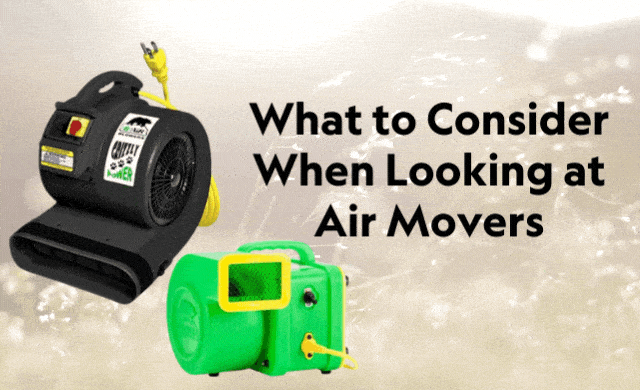If you want to have an area that is frequently damp or humid, like a dish room, then an air mover may be a good investment for your operation. Air movers are excellent solutions for cleaning, drying and ventilating indoor spaces and are often the better choice than traditional commercial floor fans. You’ll frequently see them in new construction sites because they create air flow and circulation that will expedite drying of paint or drying out plaster. They are often utilized when cleaning carpets because the air movement helps to speed up the drying process and will be found among the janitorial supplies of many maintenance departments. In foodservice, they can be used to circulate air in the kitchen or front-of-the-house when the floor has been washed to speed up the drying process. And they can be beneficial in a hot, humid dishroom to simply make it more bearable for the staff.
Air movers are available in different styles and sizes and strength. If you think an air mover might be right for you then you will want to review the following considerations before making a purchase.
1. Why are you buying an air mover? There are many functions including ventilation, reducing fumes or chemical odors, drying floors and for water damage restoration work where an air mover is a great tool. If you identify how you will be using your air mover, you will have an easier time choosing the right one for your needs. Pay attention to the air movers that provide rapid air circulation because this is key to shorten the working time in drying projects. If you are looking to reduce fumes, then the circulation speed is less important to your needs.
2. How fast and powerful an air mover do you need? Power and speed are primary variables when looking at different air movers. The power is about how much force there to the air flow coming from your air mover. If you are using the air mover to circulate air in an exceptionally large space, more power is important. Speed is how fast the air moves from your air mover. If you are looking to speed up the drying process in a wet carpet or floor, then you need to rapidly move air across the floor to reduce the amount of effectively reduce the moisture on the floor or in the carpet. Additionally, when you are looking at power, you need to pay attention to how long it can maintain the level of power that you need. Horse power is the measurement used to gauge the power of an air mover. To evaluate speed, you will be looking at the frequency of the turn of the fan blade or the rpms. Keep in mind that with greater speed, you frequently get greater noise levels.
3. Does it have the proper Safety Certifications? Like any piece of commercial maintenance equipment, safety is important. One of the best ways to know that equipment is safe is to select a product that has all the proper safety certifications, in particular the electrical certifications like UL certified. Check the manual or specification sheets for the proper certifications and guarantees that the machine is safe for use.
4. What level of horsepower and CFM will best suit your needs? The higher the horsepower of an air mover, the more powerful it will be. CFM, or cubic feet per minute, is a measurement of the amount of air that can be produced and released in a minute by the machine. This is a common measurement for ventilators or air movers, and a machine with a higher horsepower will have a higher CFM. To determine how powerful you need your air mover to be, you need to go back to question one and review what you need the air mover to do. When you know how you will use your new air mover, you can answer this question. If you looking to circulate air in smaller rooms to reduce odors, then a smaller air mover like the B’air Cub Air Mover is a good solution. For larger jobs, you would want to look at a machine with 1 HP like the B’air Grizzly Air Mover.


















